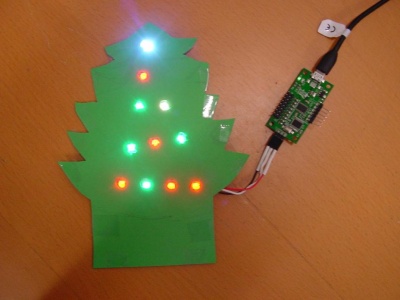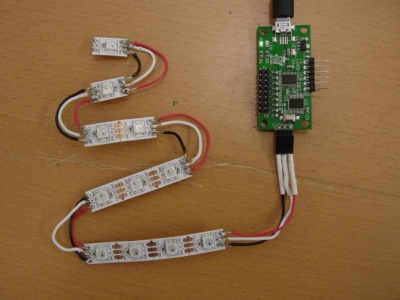Blog 24
Working with RGB leds on the WS2812
For Linux/Raspberry:
apt-get install ckermit
If you use and other device, or want to know more:
C-Kermit
For Windows users it's optional to use:
PuTTY
RGB lighted paper Tree
Making the construction
Paper tree: The paper tree is made by folding a green paper. On the folded green paper I put my RGB led connection. Around the RGB led I draw a Christmas tree. At the point every single RGB led were laying I put a dot with a pencil. After that I cut the tree and put holes only on paper with the pencil dots. After that I used some scotch tape to bring it all together. The final result:
You can of course go all crazy with the tree by adding glitters and stuff like that.
The code
The c-program RGBTree.c can be downloaded: here.
#include <stdio.h>
#include <stdlib.h>
#include <unistd.h>
#define WHITE 0xffffff
#define YELLOW 0xffff00
#define RED 0x800000
#define GREEN 0x008000
#define BLUE 0x0000ff
#define BLACK 0x000000
int nfadesteps = 30;
int delayms = 30;
int interpolate (int c1, int c2, int shift, int pos, int end)
{
c1 >>= shift;
c2 >>= shift;
c1 &= 0xff;
c2 &= 0xff;
return c1 * (end-pos) / end + c2 * pos / end;
}
void fadeto (int pixnum, int col1, int col2)
{
int i;
int r, g, b;
for (i=0;i <= nfadesteps;i++) {
r = interpolate (col1, col2, 16, i, nfadesteps);
g = interpolate (col1, col2, 8, i, nfadesteps);
b = interpolate (col1, col2, 0, i, nfadesteps);
printf ("pix %d %06x\n", pixnum,
(r << 16) | (g << 8) | (b << 0));
usleep (delayms*1000);
}
}
int main (int argc, char **argv)
{
int nleds = 10;
int *pixels;
int pixnum, newcolor;
int i;
if (argc > 1)
nleds = atoi (argv[1]);
pixels = calloc (nleds, sizeof(int));
printf ("pix %d %06x\n", nleds, WHITE);
for (i=0;i < nleds;i++){
if (random () % 2 == 0)
pixels[i] = RED;
else
pixels[i] = GREEN;
printf ("pix %d %06x\n", i, pixels[i]);
}
while (1) {
pixnum = random () % nleds;
if (pixels[pixnum] == RED)
newcolor = GREEN;
else
newcolor = RED;
fadeto (pixnum, pixels[pixnum], newcolor);
pixels[pixnum] = newcolor;
}
exit (0);
}


